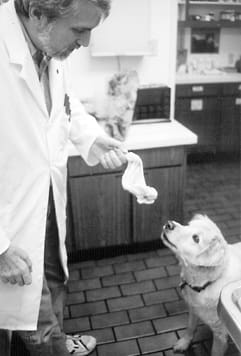For a machine to work properly, it requires the manufacturer’s recommended fuel, lubrication, and maintenance. The same is true for our dogs (and ourselves). In the wild, every creature will find and choose the foods most suitable for its evolutionary development. Our dogs evolved to eat – mostly – other animals. Their strong jaws were designed to crush bones, and their sharp teeth to tear raw meat. So say the innovators who developed so-called “BARF” diets for dogs. BARF is an acronym that stands for either Biologically Appropriate Raw Food, or Bones And Raw Food; the terms are used interchangeably.
There are thousands of dog guardians who feed their dogs homemade BARF-based diets, buying all the ingredients and preparing their dogs’ meals from scratch. People who utilize home-prepared diets are happy to discuss the many benefits of this feeding method for their dogs, including clean, tartar-free teeth; fresh breath; strong bones, muscles, and joints; a glossy coat; a healthy amount of energy and a balanced temperament; and overall vibrant good health.
For all the people who have made the leap to a homemade, meat-based diet for their dogs, however, there are many more who would like to make the change, but who are intimidated by the challenge of “getting it just right.” Some are afraid of failing to present their dogs with a balanced array of nutrients; others fear bacterial contamination from handling raw meats.

It’s all here
The advent of the commercially prepared, frozen meat-based diet is the answer to these people’s prayers. Today, more than a dozen companies offer their versions of the BARF diet, so it’s almost as easy as buying and feeding kibble. These products are a convenient, safe way to feed a raw-meat diet. Most of these diets are intended to be fed as a dog’s “complete and balanced diet,” although a few manufacturers also market supplemental meats and meat-based foods. Some are available only in a local area, while others are available nationally. Some are quite comparable in price to food that you might buy and prepare yourself; others are more expensive, but generally make up for this in the high quality of the ingredients.
There are definite differences, however, so it’s good to do a little footwork up front to find the company with the product (and pricing) that works best for you. We contacted 15 BARF manufacturers and discovered widely differing philosophies about everything from what should be in the mix to how the food should be shipped to your door.
The latter is actually an important point. While a few pet food and health food stores around the country are starting to carry these foods in freezers in their pet food sections, chances are you’ll have to mail order your food. We found significant differences in the quality of the shipping packaging, which can make a difference if your food is likely to sit on the porch until someone gets home to put it in the freezer.
To ensure that your dog benefits from an improved diet, choose the products that work most comfortably for your budget and your lifestyle.
Based on bones
The inclusion of fresh, raw bone in a BARF diet is supposed to be key to its resemblance to a dog’s evolutionary diet – and to its benefits. But only some of the manufacturers whose products we examined include bone.
Some manufacturers utilize beef bone in their mixtures, but others found it too difficult to grind the bone fine enough or to find a reliable source of organic beef bones. These manufacturers use ground chicken bones instead. Some companies add calcium supplements to their products. A final group sells – and recommends that you feed – a separate bone or calcium supplement.
Don’t forget the veggies
All the manufacturers see vegetables as an essential part of a dog’s diet, although not all of them include them in their meat mixes.
Celeste Yarnall, owner of Celestial Pets, recommends that 40 percent of the dog’s diet be carbohydrates from fiber-rich fruits and vegetables, plus a small amount of grain such as slow-cooked oatmeal. The other 60 percent of the diet, she says, should be half low-fat, raw meat or poultry protein, and half bones and supplements.
Dr. Ian Billinghurst, one of the earliest proponents of the BARF diet and recent founder of BARFWorld, a new raw dog food company, recommends a different ratio: 60 percent raw, meaty bones; 15 percent crushed vegetables: 10 percent offal (organs and intestines); 5 percent fruit; and the remainder as supplements such as kefir and kelp.
Most of the manufacturers mix the veggies into their products. A few offer a choice of meat or meat and vegetable mixes. A third group sticks to straight meat mixes and suggests you add your own veggies. One company (Three Cheers Raw! Raw! Raw!) offers a “Raw Slaw” that is a vegetable mix you add to their meat mixes; it looked and smelled so good I wanted to try it myself! Its label also includes suggestions for adding your own fruits and veggies.
The other thing to look for is whether the vegetables are fresh or frozen before they’re processed. You won’t find this information on the label, so if it’s important to you, go ahead and ask. Most use fresh and organic fruits and vegetables.
Grain isn’t for every dog
Grain is a small part of the diet in the wild, finding its way into the mix when a wild carnivore eats grain-eating prey. Most of the BARF mixes we looked at were grain-free, but this varies by company and even by product. Check the ingredients to make sure your dog isn’t getting something he can’t tolerate (all the companies clearly list their ingredients).
Don’t panic, it’s organic
Most of the companies whose products we examined use human-grade meats. Some go one step further and use only hormone- and antibiotic-free meats. Organic vegetables and grains may be found in some of the products, too.
Holistic veterinarians agree that reducing the toxic burden that our dogs must carry through their lifetime contributes to better health and longevity. Because most dogs are exposed to a plethora of pesticides, herbicides, cleaning agents, and other chemicals in their short lifetimes, holistic practitioners argue that their food, at least, should be as pure as possible. We’d give bonus points to manufacturers who strive to include organic ingredients in their products.
Supplemental information
Some of the products we examined are guaranteed to be “complete and balanced,” meaning a dog eating them would require no further supplements. But some of the companies sell meat-based mixes that are intended to be supplemented. And, of these companies, some make and sell the supplements themselves, and others advise and/or encourage owners to choose and add supplements themselves.
“We like to keep it simple,” says Tim McCallean of Grandad’s Pet Foods. “We’ve been doing this for 30 years, and we think it works best when we provide the basics and encourage the dog owner to work with the veterinarian or breeder to determine what supplements to add based on the animal’s health and activity.”
The kibble question
The principals at two companies, Steve’s Real Food for Dogs and Grandad’s Pet Foods, believe it’s all right to mix the BARF with kibble if that makes it more affordable. They reason that it’s better for a dog to have at least part of his diet providing fresh, wholesome nutrients, even if the rest of the diet is less beneficial. Steve’s Real Food is even made to look like large kibble nuggets so it mixes easily with dry food. “Eighty-five percent of our customers mix our food with dry kibble,” says Steve Brown, of Steve’s Real Food. “We’ve found that even if just 25 percent to 50 percent of the calories come from our food, the dogs thrive.”
Most of the other manufacturers we talked with felt it was okay to mix their products with the dog’s usual kibble or canned food during the introductory phase to help the dog’s digestive system adapt, but the goal was to eliminate cooked, processed foods and replace them with a whole, raw food diet.
Dr. Ian Billinghurst makes a point in his latest book, The BARF Diet, that carbohydrates, a major constituent of most kibble foods, are not an essential, or even natural part of a dog’s diet. He points to research that shows how a carbohydrate-based diet leads to a rise in blood glucose, which in turn causes a pathological rise in insulin. This leads to conditions such as diabetes, obesity, arthritis, and inflammatory illnesses. It may also play a role in promoting cancer, he says.
The bottom line
Our observations about a dozen commercial raw, frozen diets are charted on the next two pages (see sidebar at end of story). We are aware of a couple more commercial diets, but their makers declined to participate in our survey.
If you want more information before you decide if BARF is something you want to try, do contact the manufacturers. A number of them have good research about their diets and all welcome the opportunity to share what they’ve learned through research and personal experience. Contact information is included in the table on the next page.
As with many natural health alternatives, it can take a while for the mainstream medical world to discover and embrace the benefits of something that isn’t backed by large companies. WDJ has published many articles on the benefits of home-prepared diets, and will present more soon (see sidebar, “Raw Information, Past and Future”).
Also With This Article
Click here to view our review of commercial raw, frozen diets.
Click here to view “Frozen Raw Meat Diets for Dogs”
-by Rona Distenfeld
Rona Distenfeld is a freelance writer from Austin, Texas.





